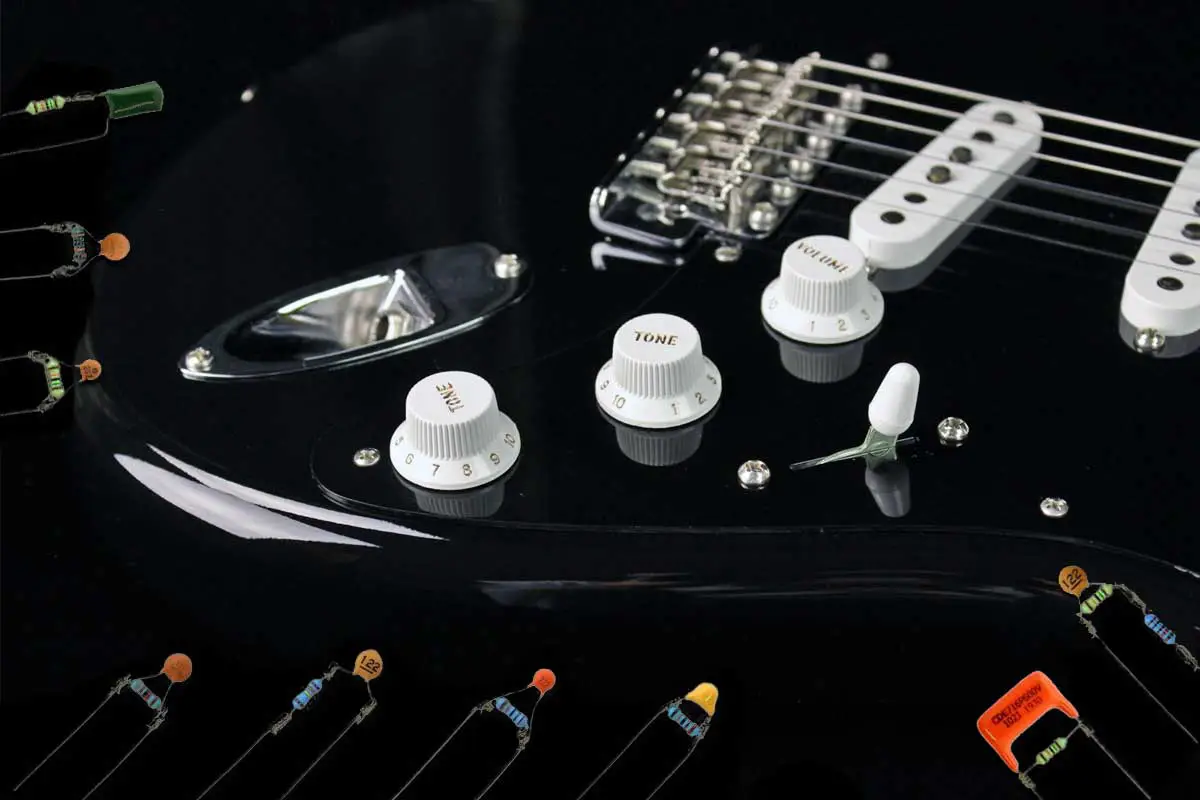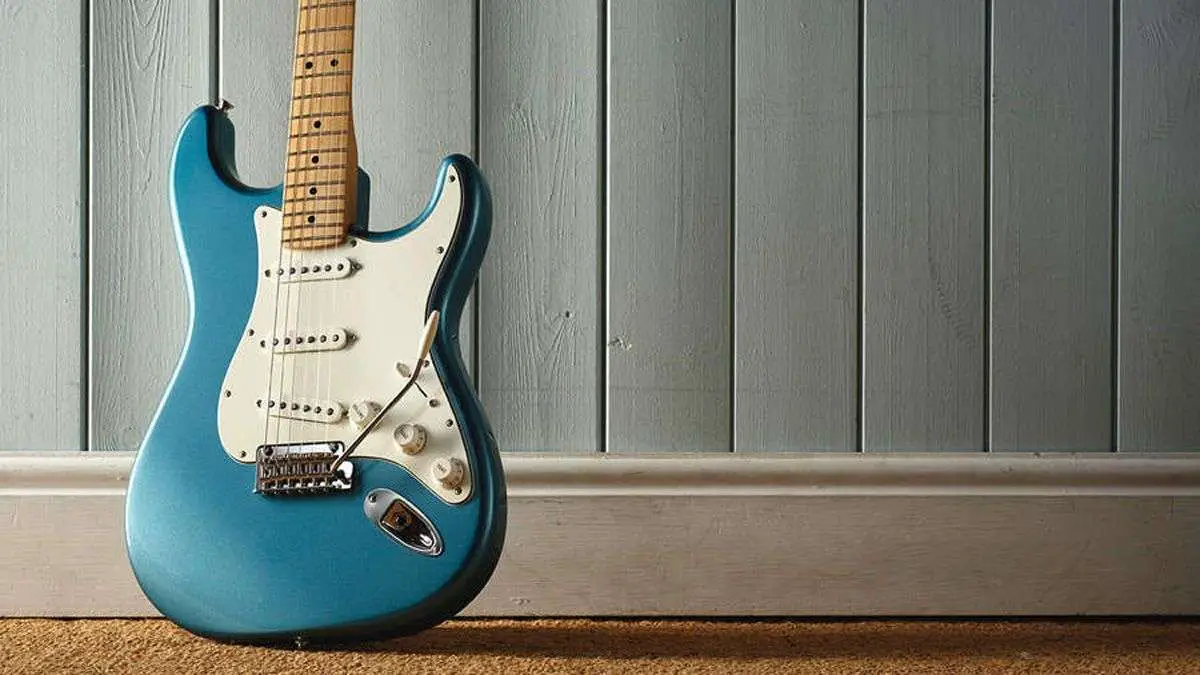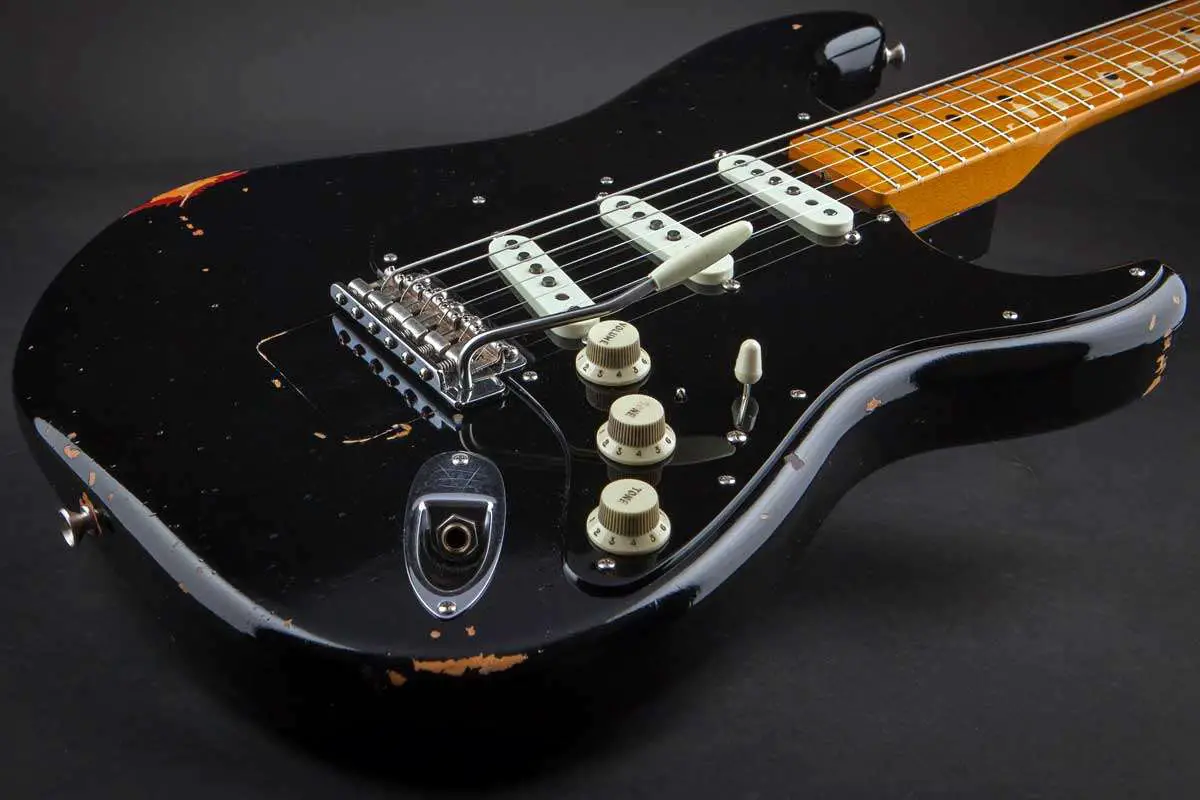In the realm of electric guitars, maintaining the integrity of your tone as you lower the volume can be a challenge, especially with instruments such as the Stratocaster. A Strat treble bleed is a mod employed to address this concern, ensuring that your high-end clarity doesn’t diminish as you turn down the volume knob. By retaining the bright, crisp sounds that Strats are renowned for, the treble bleed modification helps your guitar cut through the mix, even at lower volumes. Mind you, this modification can be done to any guitar, not just a Stratocaster.
On a technical level, the strat treble bleed circuit involves a small capacitor, and sometimes a resistor, connected across the volume potentiometer. This circuit allows high frequencies to bypass the volume pot’s resistance, and in some cases, a parallel resistor is added to shape the bleed’s frequency response and taper, providing you with a smoother transition as you adjust volume. Guitarists often opt for this upgrade to enhance their tone’s versatility, allowing for expressive dynamics without losing the essence of their sound. Whether you’re coaxing tender, chiming cleans at bedroom levels or need to roll back a touch of volume for rhythm parts on stage without losing definition, a treble bleed might just be the solution you’re seeking.

Fundamentals of Treble Bleed
Defining Treble Bleed
Treble bleed is a modification commonly added to the volume control circuit of electric guitars to prevent the loss of higher frequencies when reducing the volume. As you lower the volume on your guitar without a treble bleed, you might notice that the sound becomes warmer and less clear.
To counteract this, a treble bleed circuit can be installed. This circuit typically consists of a capacitor, and sometimes a resistor, wired in parallel or series with the guitar’s volume pot.
Physics Behind Treble Bleed
The rationale behind treble bleed emanates from the way electrical components—capacitors and resistors—influence an audio signal. A capacitor allows high-frequency signals to pass through while impeding low frequencies, and a resistor can adjust the current flow.
Together in a treble bleed circuit, they form a high-pass filter, letting your guitar’s treble response stay more consistent as the volume pot is turned down. It’s the interaction between these components that defines the behavior of your sound at lower volumes.
Importance of Treble Bleed in Guitar Tone
With the inherent challenge of retaining treble in reduced volume settings on guitars, the treble bleed mod becomes significantly important. By embedding this small circuit, you ensure a fuller and brighter tone, even at lower volumes.
The treble bleed keeps the sparkle in your guitar tone, giving you a greater range of expressiveness without compromising sound quality. It is your secret tool for a potent and vibrant sound, making it especially useful during performances where dynamic control is essential.
Treble Bleed Components
In a Stratocaster, the treble bleed mod is integral for preserving the clarity of your tone as you adjust the volume. Understanding the components and their values is key to achieving the perfect sound.
Capacitors and Their Role
Capacitors are crucial in a treble bleed circuit, as they allow high frequencies to bypass the volume pot, retaining the treble as you roll back on your guitar’s volume. The capacitance of a capacitor is measured in farads, with most treble bleed mods using values in the picofarad (pF) to nanofarad (nF) range. A common capacitor value is around 0.001uf; however, if you find this makes your tone too bright, you can opt for a smaller value, like 800pf, to find a better balance.
Resistors in Treble Bleed Circuits
Resistors control the current passing through the treble bleed network, affecting how the high frequencies are preserved. A higher resistance value generally means a more pronounced treble retention. Typically, a 150k ohm resistor works well, but this can be adjusted depending on your tonal preference and the other components of the circuit. It’s essential to consider the interaction between the resistor and the capacitor to ensure they work in harmony for the desired output.
Choosing the Right Treble Bleed Values
Choosing the right values for your treble bleed components involves a bit of experimentation to suit your tone preferences. The treble bleed mod works passively; it can only filter, not boost frequencies. The values should be chosen to keep your tone consistent at varying volume levels, without making it too piercing or too dull when rolling off the volume. American Professional Stratocasters often feature a standard treble bleed circuit that can serve as a starting point for the values you might choose. Remember, pots have different taper characteristics and will affect how the mod reacts, so consider these variables when dialing in your sound.
How To Install a Strat Treble Bleed Mod
Installing a treble bleed circuit in your Stratocaster can enhance your guitar’s tonal clarity when lowering the volume. This section will guide you through the necessary preparation, the exact soldering steps, and how to test and troubleshoot the treble bleed installation.
Preparation for Soldering
To begin, ensure you have all the necessary tools and components for the job. You’ll need:
- Soldering iron: Select one that is easy to handle and heats up to the appropriate temperature for working with electronic components.
- Solder: Typically, a tin/lead 60/40 solder or lead-free with added silver is used.
- 0.001uf capacitor: This is the component that allows high frequencies to bypass the volume control.
- Resistor: A common value used is 150k, but other values like 100k or 130k are also popular.
- Wiring diagram: A reference for how the treble bleed circuit integrates with an American Pro Stratocaster for example, can be found here.
- Heat shrink tubing: Optional, but useful for insulating the connections.
Gather your materials and tools, clear a well-lit workspace, and have your wiring diagram at hand to refer to the appropriate connection points.
Step-by-Step Guide
- Safety First: Unplug your guitar and work in a well-ventilated area. Use safety glasses to protect your eyes from solder splashes or vapors.
- Access the Electronics: Open the back panel or pickguard of your guitar to access the electronics.
- Identify the Volume Pot: Locate the volume pot. It’s usually the one connected to the output jack.
- Choose the Components: Decide on the value of the capacitor (typically between 0.001uF and 800pf). Some players add a resistor in parallel with the capacitor (common values range from 100k to 220k ohms).
- Prepare the Components: If you’re using a resistor, solder it to the capacitor leads before installation.
- Solder the Treble Bleed Mod: Solder one lead of the capacitor (or the resistor-capacitor combo) to the middle lug of the volume pot. Solder the other lead to one of the outer lugs (the one connected to the pot’s casing).
- Test the Connection: Before reassembling, gently tug on the capacitor and resistor to ensure they’re securely soldered.
- Reassemble the Guitar: Carefully place the components back into the guitar, ensuring no wires are pinched or components are touching where they shouldn’t.
- Test the Mod: Plug in your guitar and test the volume knob. You should notice that the high frequencies are now more present at lower volumes.
- Adjustment (Optional): If the treble bleed effect is too strong or too weak, you may want to experiment with different capacitor values or add/remove the parallel resistor to fine-tune the response to your liking.
Remember, if you’re not comfortable with soldering or working with electronics, it’s best to consult with a professional guitar technician.
Guitar Setup & Treble Bleed
Implementing a strat treble bleed mod into your guitar’s volume pot can preserve your high frequencies as the volume is lowered. This modification can significantly alter the interplay between your pickups, controls, and the performance of your amp and pedals.
Pickup Selection for Optimal Use
When considering the treble bleed mod, your choice of pickups matters. If you’re using single coils, which are naturally brighter, you may opt for a subtle treble bleed circuit to maintain clarity without becoming piercing. For humbuckers, which have a warmer tone, a larger value capacitor in the treble bleed might be beneficial to retain the articulation of high-end frequencies as you decrease your volume knob.
- Single Coil: Subtle treble bleed can maintain brightness without harshness.
- Humbucker: Larger capacitor values can help articulate highs at lower volumes.
Volume Pot Taper and Tone Control
The volume pot taper influences the behavior of the treble bleed circuit. Audio taper pots provide a smoother transition across the volume range, which can be pleasant when combined with a treble bleed. However, linear taper pots may give you a more direct relationship between the position of the volume knob and the output level, potentially making it easier to dial in the perfect balance.
- Audio Taper: Smoother volume transitions, softer impact on treble bleed.
- Linear Taper: Precise control over volume levels, more predictable treble bleed effect.
Your tone pot interacts closely with the treble bleed circuit and can further shape your high-end response. If you find the result of the treble bleed too bright, the tone control can tame excess highs.
Effect on Amps and Pedals
A strat treble bleed mod can change how your guitar interacts with your amps and pedals. With higher frequency retention at lower volumes, your amps might exhibit a brighter character, especially tube amps that respond dynamically to input signals. Pedals, particularly overdrives and distortions, often soften high frequencies, so a treble bleed might help retain definition that would otherwise be lost when rolling back the volume knob.
- Amps: Expect brighter amp response, especially in tube models.
- Pedals: Overdrives and distortions retain more definition with a treble bleed.
Treble Bleed Variants
Treble bleed mods allow you to maintain the clarity of your guitar’s high frequencies as you lower its volume. Variations of strat treble bleed circuits and modifications ensure that your instrument’s tone remains consistent across different volume levels.
Different Circuit Designs
There are several ways a treble-bleed network can be implemented, each affecting the tone in a unique manner. A typical mod involves adding a capacitor across the volume control, allowing high frequencies to “bleed” through even as the volume is decreased. However, combining a capacitor with a resistor either in parallel or in series can change the behavior of the volume control taper and the overall sound.
- Parallel: Often, a small-value capacitor is placed in parallel with a resistor. The resistor’s value will influence the amount of treble that bleeds through, with higher values preserving more highs at lower volumes.
- Series: Alternatively, some players place the resistor in series with the capacitor, which can result in a different taper and frequency response.
Seymour Duncan’s blog suggests that a simple capacitor may sometimes suffice, but additional resistor(s) can refine the frequency response.
Manufacturer-Specific Variations
Different guitar manufacturers incorporate their own versions of the strat treble bleed circuit with signature components and values:
- Fender has equipped many of their American Professional series guitars with treble-bleed circuits that include a capacitor and two resistors, one in series and another in parallel.
- PRS (Paul Reed Smith) guitars often use a 180 pF capacitor without any additional resistors, fitted to their 500 kΩ volume pots.
- Kinman is known for their treble bleed mod, which includes specific values tailored to their pickups to ensure a transparent and clear tone at all volumes.
Custom Treble Bleed Modifications
Guitarists looking to personalize their sound can experiment with various treble bleed mods, altering capacitor and resistor values:
- Starting Values: A common starting point is a .001uf capacitor and a 150k resistor. Adjust from there based on desired brightness; less capacitance for less high-end or more for additional brightness.
- Adjusting to Taste: For a change in the taper, varying the resistor’s value can provide more or less gradual volume decrease.
Technical Considerations
When you modify your Stratocaster with a treble bleed circuit, you’re directly affecting the frequency response and impedance of your guitar’s signal. Understanding these technical elements is crucial for tailoring your guitar’s tone to your preferences.

Impact on Impedance and Frequency
The input impedance of your guitar’s pickups plays a crucial role in how frequencies are transmitted through the volume pot. When the volume is lowered, high frequencies typically diminish; however, with a treble bypass filter, this is altered. A cap only in a parallel circuit can prevent loss of treble as volume decreases, effectively allowing highs to remain prominent even at lower volumes.
Balancing Highs and Lows
Managing the balance between highs and lows is an art and a science. The values you choose for your strat treble bleed components will determine the extent to which high frequencies are preserved. A common strat treble bleed circuit involves pairing a capacitor with a resistor. When connected in parallel to the volume pot, this network allows highs to “bleed” through the circuit, thereby maintaining a bright sound at various volume levels.
Bypassing vs. Bleeding Treble
“Bypassing” and “bleeding” in the context of guitar electronics are often used interchangeably, but they highlight different aspects of the circuit’s function. The treble bleed allows high-end frequencies to bypass the volume control’s natural roll-off effect. In contrast, a treble bypass filter (usually a capacitor or a resistor-capacitor network) ensures that as you turn the volume down, your tone remains consistent—highs don’t get subdued—a phenomenon often referred to as “bleeding treble,” hence the confusion between the terms.
Practical Tips
When it comes to maximizing your Stratocaster’s performance, practical tips can elevate your playing experience by ensuring tone clarity and optimum interaction with your gear. Here’s how you can maintain the essence of your sound across various volume levels and gear configurations.

Maintaining Clarity at Low Volumes
To preserve your guitar’s clarity when rolling back the volume, consider installing a strat treble bleed circuit. This involves attaching a capacitor and a resistor in parallel to the volume pot. For example, a common starting point is a 0.001uf capacitor with a 150k resistor. This combats the natural loss of high frequencies as you decrease the volume, keeping your tone consistent at different playing dynamics. Adjust the capacitor value to modulate brightness levels, ensuring your guitar’s tone remains articulated, even at lower volumes.
Influence of Cable and Signal Chain
Your guitar cable and the rest of the signal chain can also affect clarity and tone. High-quality cables with lower capacitance can help maintain high-frequency response, especially beneficial when using a treble bleed mod. Every component in the signal chain adds its own coloration to the sound. To preserve the brightness that a treble bleed aims to maintain, opt for a cable that supports this characteristic rather than working against it.
Incorporating Treble Bleed in Setups
Integrating a strat treble bleed mod into your setup can slightly adjust the taper of the volume pot, which affects how your volume changes are perceived. You may notice that with a treble bleed, the transition from loud to quiet is smoother, without a stark loss in highs. If your rig includes a variety of pedals and amps, the treble bleed should enable a more dependable and predictable response from your guitar across all your guitar setups, aiding in achieving a consistent guitar tone regardless of the rig’s complexity.
